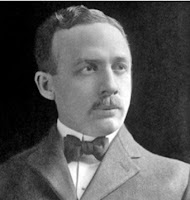This Man Had A No(ta)tion!
His name was Frederick Mathvan Whyte (1865 to 1941). He came up with a cunning plan to classify the wheel arrangement of every possible type of railway steam locomotive and it was a plan adopted world wide. Those of "a certain age" know it so well that it is hard to believe that anyone had to invent it.
But he did.
This particular list was distributed to locomotive builders in 1906.
Whyte may well have come up with the names but only a few of those made it into general use, certainly in the UK.Even today steam loco aficionados still refer to Pacific, Mogul and Prairie and in his youth fbb did occasionally see "Consol" in print. But it would be very unlikely for anyone to dare to call City of Truro an American ...
Whyte may well have come up with the names but only a few of those made it into general use, certainly in the UK.Even today steam loco aficionados still refer to Pacific, Mogul and Prairie and in his youth fbb did occasionally see "Consol" in print. But it would be very unlikely for anyone to dare to call City of Truro an American ...
In very simple terms the middle number of the three was the total number of wheels actually driven by the steam engines gubbins. The other numbers were the various load bearing but not driven bogies. (Although if the bogie has just two wheels is was always called a pony truck!!)
But any good trainspotter with his notebook and pencil would be able to refer to the wheel arrangement diagram in his Ian Allan "Combined" volume and sound very knowledgeable at the trackside.
But this system would come unstuck with diesels. Most did not have coupled wheels or extra bogies. There was GT3 ...... and The Fell.Most numerous where diesel shunters which also retained the Whyte notation as 0-4-0 or the ubiquitous 0-6-0.
A Different Scheme
It starts of very simply.
Most main line diesels have two bogies driven by motors, usually elelctric, which were powered from a huuuuge diesel engine driving a generator. So if the bogie has six driven wheels (usually three on each side) the bogie was given the letter "C".The letter "B" would be used for 4 wheel bogies.Seemples?
Hmm, not quite.
If each of the three axles had its own separate motor (usually called axle-hung) a small case "o" was added.
But look at this D200 class (type 40).You can spot eight wheels on the bogie - But the front two are smaller and NOT powered.
So a Class 40 is designated a 1Co-Co1.
No-No!
It is an A1A-A1A! The centre pair of wheels on each bogie is NOT powered, hence the number 1. Although the outer pairs of wheels are separately powered, that is obvious as there are ony two of them in each case, so thay can only be individually powered.
===================
Model Railway Aside
The A1A-A1A was the first realistic diesel loco produced by Triang (in 1963???) and it remained in the catalogue well into the Triang Hornby days before being replaced by a slightly better model that Hornby took on when it bought out Lima.
Thus video shows a selection of the original in various liveries.
It was a very nice model for its day.
===================
It really is very simple, with one more option. If two bogies are articulates, i.e. mechanically joined, you replace the - with a +.
So this loco, an American U50 class is a B+B-B+B!At each end it has TWO four wheel bogies which are articulated together making a mechanical pairing of two sets of 4 wheels (that's 8) - B+B! That makes 16 wheels in total.
Wheely powerful! GROAN!
So, after a thorough lesson on diesel wheel arrangements, readers may be able to understand the headline on today's blog - or, at least work out what a Co-Bo might be!
Who said that diesels were boring when compared with steam locos?
If a diesel is a tin box, then a steam engine is a kettle!
Pause for thousands of aged railway enthusiasts to stick sharp pins in a wax model of fbb to effect excruciating pain!Definitely OUCH!!
Next Cobo Boco Loco blog : Saturday 20th April
















I'm intrigued by the picture of the Class 37 in early BR black livery, clearly mimicking the LMS locos 10000 and 10001. Is this a real livery or a Photoshop creation? - I suspect the latter.
ReplyDeleteAnd, of course, GT3 wasn't a diesel (as I'm sure you know). Conversely, the Walker diesels in Ireland (think West Clare Railway and various railcars) had connecting rods on their motor bogies.